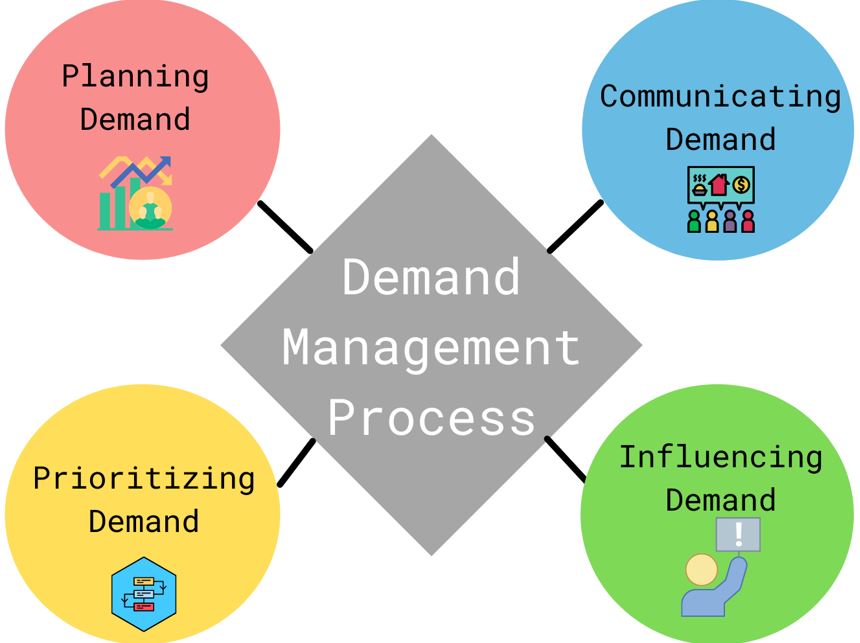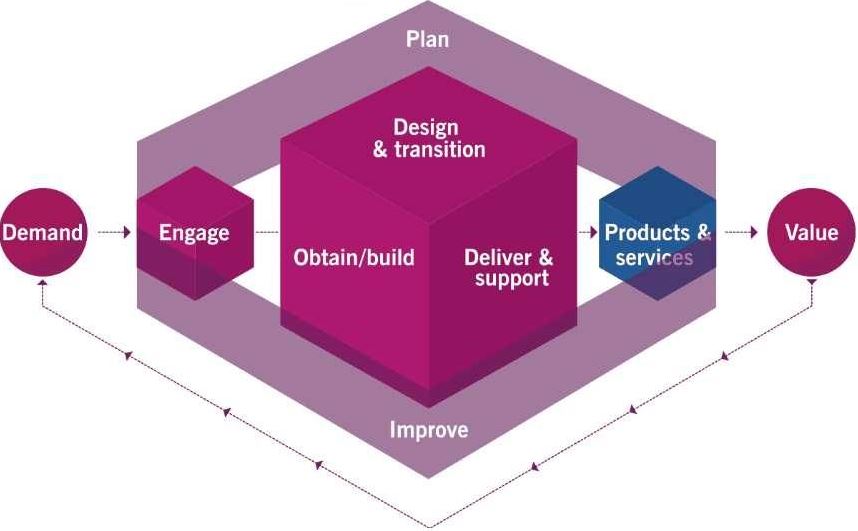
Design an Effective IT Service with ITIL® v3 Tutorial
Last updated on 11th Aug 2022, Blog, Tutorials
What is ITIL demand management?
ITIL demand management helps a business perceive and predict client demand for services. Each business is subject to alternating behavior. per ITIL, the aim of demand management is to grasp, anticipate, and influence client demand for services.
This means that demand for services will grow or shrink with the trade cycle. when making a decision whether or not to produce a service, IT Service Management should perceive the patterns of endeavor (PBAs) associated with the service. whereas it’s vital to avoid having inadequate capability, the excess capacity is additionally a business risk, involving expense which usually can’t be recovered, since customers can’t be expected to purchase capability they#39;are not exploiting.
PBAs are usually thought of in terms of dealings volumes. ITIL suggests alternative factors be thought of Similarly, like the supply of the demand, special desires like increased security, and tolerance for delay. the work of demand management is to spot acceptable PBAs and to associate them with user profiles (UPs). This becomes vital input to the capability management method within the Service style lifecycle section.
As a method, it&s a part of the ITIL service strategy stage of the ITIL lifecycle. Service strategy determines that services to supply to prospective customers or markets. the selections that are created within the service strategy stage have an effect on the service catalog, the business processes, the service table, the specified capability, and therefore the money necessities of the service supplier.
As a part of the service strategy stage, demand management rationalizes and optimizes the employment of IT resources. It ensures that the quantity of technical and human resources that have been budgeted matches the expected demand for the service. If the prediction is just too low, the agreed-upon service levels might not be delivered. If the predictions are too high, resources can are allotted to a service that will not be used (or paid for). Demand management bridges the gap between service style, capability management, and relationship management to make sure that the predictions are correct.
Demand management could be a method inside ITIL thats additional confirmative of alternative methods than a self-contained process. not unlike incident management, as an example, the activities within demand management aren’t visible to the client. once service demand isn’t properly balanced, it affects nearly every part of the ITIL lifecycle.
Demand management roles
Like each method inside the ITIL framework, demand management incorporates a chain of responsibility and possession. Here, the homeowners are referred to as relationship managers. relationship management creates and grows the affiliation between the client and therefore the service supplier.
Demand management objectives and activities

The purpose of demand management is to discover and influence the demand that customers wear IT services. This method involves 3 main actions:
Analyzing current client usage of IT services: the best thanks to doing that is to investigate service table information concerning incidents, requests, and issues. Network usage and period will be measured via a service dashboard, like the sort utilized in network operations center (NOC) surroundings.
Anticipating future client demands for IT services: Here, the relationship manager comes into play. He or she could speak with the client directly concerning forecasted desires, can analyze trends in usage or tickets, and can build educated predictions concerning future usage supported by similar customer trends.
Influencing consumption as necessary by money or technical means: as an example, if a client uses additional service than anticipated within the SLA, a service supplier could charge fees for the excessive consumption to offset the prices of the unforeseen demand. Demand management additionally makes positive that the acceptable prices are enclosed within the service style. Formally, this involves 2 processes:
Demand prognosis
In demand prognosis, the relationship manager analyzes IT service consumption. This individual will forecast future consumption supported by far-famed data, like consumption trends and service-quality feedback from the client. Sometimes, the client can directly indicate once additional capability or a good a range of services are required. In ITIL, this is often referred to as the Pattern of endeavor (PBA). per ITIL, the PBA could be an employment profile of 1 or additional business activities that helps service suppliers establish usage patterns.
The pattern of endeavor measures the subsequent aspects of client service usage:
- Frequency
- Volume
- Duration
- Location
The volume of usage is the quantity of activity. as an example, this might be {the range the amount the quantity} of transactions processed or a service table price tag number. The Volume will increase or decrease.
The frequency of usage is however usually the quantity of usage that happens.
The location of usage is wherever the business usage occurred. Is it within the service table or the business department, for example?
The PBA additionally includes a user profile, which could be a pattern of service usage that#39;s tied to a sort of user. as an example, developers could have a better info usage pattern than business users.
Demand management
Demand management is the approach that suppliers manage IT service consumption. this will be done through technical means (such as network throttling) or money means that (such as hyperbolic charges for usage beyond the agreed-upon levels). The management is enforced till the capability for larger demand is enforced into the service catalog.
Developing differentiated offerings and repair packages additionally control demand. Differentiated offerings and repair packages management demand and {value} while providing the client with the services they use and value most.
The ITIL demand management communication flow

Demand management differs from other processes in the ITIL lifecycle in that it doesn’t rely on a standalone set of procedures but rather on communication between various processes. Demand management interacts with the other service strategy lifecycle stages, in contrast to certain other procedures. Demand management, on the other hand, collects client input from the PBA and the business relationship manager.
The information gathered and the decisions made, on the other hand, are used by demand management to inform numerous other operations.
In service planning, demand management is used in conjunction with service portfolio management to finance the addition of new services and capacity expansion.
When the data gathered is utilised to confirm that the new service catalogue satisfies the pattern’s expected demands, it may be shown in service transition.
It serves as the terminus for service desk input in service operations. The service desk notices patterns in how frequently services are used and communicates that information to demand management, which informs capacity management to adjust resources as necessary.
Finally, demand management is seen in continual service improvement (CSI) once the information from Demand management and also the PBA ar accustomed proactively improve services supported usage forecasts.
Why is ITIL demand management therefore important?
Demand management is crucial for one easy reason: it’s not possible to adequately arrange for and meet service demands supported gut check alone. Predicting what proportion service can increase supported what you’re thinking that you bear in mind concerning current demand versus the demand of alternative similar customers results in inaccurate knowledge at the best and pricey overstaffing at the worst. correct coming up with needs analyzing the information gathered and shopper feedback, as seen within the demand prognosis method. Inaccurate estimates have negative impacts on:
- SLA metrics
- KPIs
- Customer satisfaction
- Financial management
- Incident management
- Service Strategy
- Business relationship management
Poorly managed service demand could be a large risk for organizations. Inadequately coming up with for will increase in service usage might mean uncomprehensible service levels and poor service quality across the whole service catalog. For businesses, that might mean something from monetary implications to lost business altogether.
Related ITIL stages and processes
Demand management interfaces with several ITIL processes. As an area of the service strategy stage, it is closely aligned with service portfolio management, monetary management for IT services, and business relationship management. this is often as a result of the question of “how much” service is enough is integral to those processes. In monetary management, as an example, the question of what proportion of a service to provide directly impacts the IT budget and also the prices passed on to the service client. In service portfolio management, demand directly impacts that services ar offered within the client service catalog. service operations ar therefore conjointly impacted–, since it depends on the service catalog for its vary of services, also as on the associated capability and quality management of operations.
Demand management could be a tiny however vital element inside ITIL. obtaining demand management wrong impacts the whole organization and also the services rendered. browse on to be told concerning the opposite processes inside service strategy.
Demand Management could be a important and significant method in commission strategy. It helps to know customer demand for services in order that acceptable capability will be provisioned to satisfy those demands.
Improper demand management results in improper use of services and resources. thus it’s value analyzing customers’ demands.
The Demand Manager is that the method owner of this method.
Itil tutorial
Strategic Level Demand Management
Under Strategic Demand Management, we have a tendency to specialise in 2 vital things −
The Pattern of Business Analysis
User Profiles
The pattern of Business Analysis (PBA)
PBA is a particularly vital activity achieved by knowing customers however they operate and future requirements they could want.
User Profiles
It is the demand pattern shown by users. It will be processes, people, or functions.
Tactical Level Demand Management
Under plan of action level demand management, we have a tendency to specialise in Differential Charging. it’s a way to support Demand Management by charging totally different|completely different} amounts for a similar IT Service operate at different times.
Challenges in Demand Management
Demand Management could be a crucial method of service strategy.
Below are the challenges that occur in this method method
Improper analyses of client demand result in improper use of capability. Excess capability generates price without making price
Sometimes a precise quantity of unused capability is critical to deliver service levels. Such capability is creating price through the upper level of assurance created doable with the upper capability
It is needed to possess service level agreements, foretelling, planning, and tight coordination with the customer to scale back uncertainty in demand
Service production cannot occur while not concurrence presence of demand that consumes the output
The arrival of demand is additionally influenced by demand management techniques like off-peak evaluation, volume discounts, and differentiated service levels
Service Packages
Core Services and supporting services
Core services ar basic services that a client is willing to pay. they bring about actual price to the customer.Support services enhance the worth proposition of core services i.e. more options to key services.
Developing differentiated offerings
Packaging of core services and supporting services has implications for style and operation services. It is needed to determine whether or not to standardize the core or support services. One will reach a similar level of completely differentiation of in-service providing taking different approaches to the package as shown within the following figure.
Service packages return up with one or additional Service Level Packages (SLP). every of the service level packages provides a precise level of utility and warrantee from the attitude of outcomes, assets, and PBA of shoppers.
Are you looking training with Right Jobs?
Contact Us- Windows Azure Interview Questions and Answers
- Salesforce Architecture Tutorial
- Wrapper Class in Salesforce Tutorial
- salesforce lightning
Related Articles
Popular Courses
- VM Ware Training
11025 Learners - Microsoft Dynamics Training
12022 Learners - Siebel Training
11141 Learners
- What is Dimension Reduction? | Know the techniques
- Difference between Data Lake vs Data Warehouse: A Complete Guide For Beginners with Best Practices
- What is Dimension Reduction? | Know the techniques
- What does the Yield keyword do and How to use Yield in python ? [ OverView ]
- Agile Sprint Planning | Everything You Need to Know
